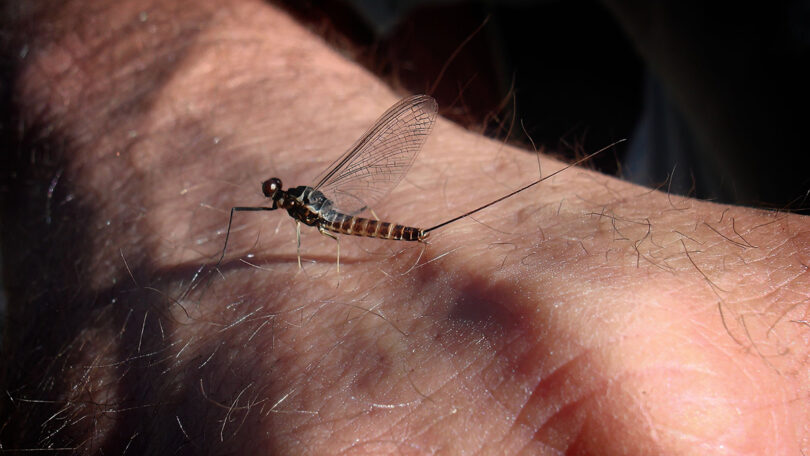By Dennis Smith
There was a huge spinner fall on the Big Thompson that morning — Pale Morning Duns, we’d guessed, but then mayfly spinners all look alike to me; they could have been anything. It was late June and we just assumed they were Pale Morning Duns, but we didn’t really know. They stretched up and down the entire length of the riffle in a perpetually undulating cloud that rose clear into the tops of the cottonwoods and, with the morning sun behind them, they sparkled like a million flickering diamonds. It was pretty damned impressive.
Technically, we should have strung up lightweight rods, floating lines, long, fine leaders, and wispy dry flies to match the spinners. Instead, we watched them for a few minutes, made the obligatory oohs and ahhs, and then defiantly rigged heavy, 7-weight rods with sinking lines, short stout leaders, and big, hairy streamers. I mean, really big. And really hairy. The sculpin imitations we used were made from 1/8-inch-wide strips of dyed rabbit fur about 4 inches long and had thick, fat heads of spun ram’s wool.
We were after meat eaters, not bug catchers.
Sculpins are minnows with flat, oversized heads and large pectoral fins. They look a bit like tiny, speckled brown bullheads. They’re common in most trout streams and they are to big brown trout what a prime rib dinner is to a cross-country trucker. For the past two weeks, we’d been hooking some hefty trout on them. Eight to be exact, all brown trout, and not one of them less than 16 inches. Three of them were over 19 inches. I know, because we taped them. Now, that might not raise an eyebrow on some rivers, but on the Big Thompson, a 29-inch trout is monster — and in heavy runoff flows, a real handful. Hence the heavy rigs.
This all started earlier in the month when I broke a fish off swinging a large wet fly through this same riffle. Murky with rain and snowmelt, the river had come up a foot and it seemed a big, dark fly would be easier for the fish to see. It was. The fly swung against a root-tangled cut bank, a fish grabbed it, lunged, broke off instantly, and jumped three times. It looked like a carp, but it wasn’t; it was a big, cannibalistic brown trout. My friend Dustin Krause and I went back the next day, and for several days thereafter, armed with the heavy rods and big streamers. That worked … for a while.
But this was the last week in June — the flows had receded noticeably, mayflies were hatching, and the trout were feeding on them. We should have switched to lighter rods and dainty dry flies, but we persisted in casting the big, hairy streamers. Naturally, we got skunked — proving once again that bigger isn’t always better.
Dennis Smith is a freelance outdoors writer and photographer whose work appears nationally. He lives in Loveland.
Like this column? Click here to read more CCL outdoor columns.

